-
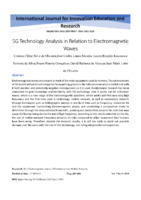 5G Technology Analysis in Relation to Electromagnetic Waves
5G Technology Analysis in Relation to Electromagnetic Waves Abstract
Electromagnetic waves are present in most of the main equipment used by humans. The advancement
of 5G mobile network technology has been gaining ground in the telecommunications market and with
it both positive and potentially negative consequences as it is used. Fundamental research has been
conducted to gain knowledge and familiarity with 5G technology, how it works and its millimeter
waves, which is a new range of the electromagnetic spectrum, which works with this new very high
frequency and the first time used in technology. mobile network, as well as exploratory research
through techniques such as bibliographic surveys in search of data such as frequency, related to 5G
and the equipment transmitting electromagnetic waves, and conducting a comparative study to
determine through the data collected from both , pointing out studies that present the evils that may
cause the human being due to the use of high frequency. According to the results obtained on the 5G,
the use of mobile network frequency presents no risks compared to other equipment that humans
have been using. Therefore, despite the research results, it is still too early to point out possible
damage over the years with the use of this technology, not ruling out possible consequences.
Keyword: 5G; Electromagnetic waves; Millimeter waves; Mobile Network;
-
 Feasibility of Frying Oil After Treatment by a Biofuel Company in Manaus - Amazonas
Feasibility of Frying Oil After Treatment by a Biofuel Company in Manaus - Amazonas Abstract
Waste generation has increased in many sectors given the demand and population growth. Reverse
logistics comes to contribute to the return of these wastes to the production chain. In this context,
frying oil is one of the most processed waste and transformed into new products, such as: biofuel,
boiler fuel, soap manufacturing, concrete formwork release agent etc. Oil is one of the wastes whose
recycling only happens by law, because it has low added value, unlike plastic, aluminum and copper,
whose values are higher. The average oil consumption in Brazil reaches 3 billion liters per year, but
only 2.5% of this total is recycled, the others are discarded in the wild. The aim of this study is to
analyze Reverse Logistics at different points, seeking to describe the chain steps, from the final
consumer, through the PEV and ending in the companies that will reuse the frying oil already treated.
In Manaus, the logistics of frying oil is done by cooperatives and private companies, being MASSEG,
the largest company in the segment. This research has an explanatory character, approaching a case
study, which made it possible to observe the financial and environmental feasibility of reverse logistics
for the collection of frying oil, carried out at Condomínio Shopping Manauara Center, in the city of
Manaus, AM. To reverse this scenario, many companies are investing in the reverse logistics process.
Procedures such as leaving drums empty so that they are filled with waste oil, separation of solid waste
and water from oil, are already part of the routine of tenants that also contribute to non contamination
of water bodies. The collection, transportation, filtering, decantation and commercialization of the
product already treated, for fuel purposes, is performed by the company itself. Finally, the company
uses part of the treated oil to manufacture biodiesel, applied to the consumption of its own fleet, with
no commercialization of the generated biodiesel. Thus there is a reduction in the use and costs with
usual fuels (fossils), seeking to add the culture of sustainability.
Keyword: Reverse Logistics, Biodiesel, Waste.
-
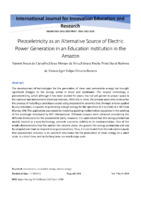 Piezoeletricity as an Alternative Source of Electric Power Generation in an Education Institution in the Amazon
Piezoeletricity as an Alternative Source of Electric Power Generation in an Education Institution in the Amazon Abstract
The development of technologies for the generation of clean and sustainable energy has brought
significant changes to the energy sector in Brazil and worldwide. The newest technology is
piezoelectricity, which although it has been studied for years, has not yet gained its proper space in
the national and international electrical matrices. With this in mind, the present work aims to describe
the process of installing a prototype carpet using piezoelectric ceramics that, through a force applied
by any individual, is capable of generating enough energy for the operation of a turnstile in a HEI from
Manaus-AM. The application was tested by modeling applying mathematical equations in the working
of the prototype developed by APC International. Different answers were obtained considering the
different dimensions for the piezoelectric parts. However, it is understood that this energy production
model, treated as a new technology, presents economic viability in its implementation. One of the
results demonstrates that the smaller the ceramic piece, the greater the energy production and can
be adapted over time to respond to large productions. Thus, it is concluded from the calculations made
that piezoelectric ceramics is an excellent alternative for the production of clean energy on a small
scale, in a short time, and in the long term can reach large scale.
Keyword: piezoelectric; sustainable energy, electric energy;
-
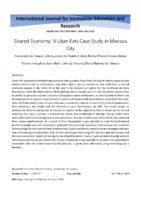 Shared Economy: A Uber-Eats Case Study in Manaus City
Shared Economy: A Uber-Eats Case Study in Manaus City Abstract
Given the prospective employment scenario that a society faces from the end of various areas due to
various factors such as automation, new labor rights, lack or creation of new audiences, a shared
economy caused in the midst of all this and It has become an option for the livelihood of many
Manauaras. With the advancement of technology many changes occur in the way urban society uses
its profits to generate income, it causes or disappears some professions, an interruption of others and
the emergence of several. It was chosen to measure the data or the food delivery application that uber
eats, which has about a year of use in Manaus, or even the concept of new forms of work organization,
their deliverers, use modal and are directed to your destinations via GPS. This study sought to
understand what is leading part of society to register in the application that is based on the shared
economy. For such a survey, a quantitative survey was conducted in Manaus City to collect data
required at high food ordering points per application, through a field survey, information was collected
from various professionals. As a result of the investigation it was possible to map the professional
profile of people who are choosing to work with this economic economy, and increase the incidence
of technology for the lives of these professionals, it was possible to measure what challenges this new
way of earning money provides, what are the advantages they bring, if it has the same advantages and
the socio-economic impact on the day to day of professionals. Finally, it was carried out by the authors
who conducted the survey, where after it was completed, it was possible to complete the applications
associated with the shared economy that use yes, a great work alternative using technology as a
medium.
Keyword: Innovation, Shared Economy, Technology, Disruption;
-
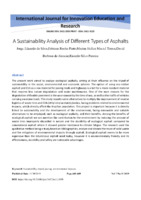 A Sustainability Analysis of Different Types of Asphalts
A Sustainability Analysis of Different Types of Asphalts Abstract
The present work aimed to analyze ecological asphalts, aiming at their influence on the tripod of
sustainability in the social, environmental and economic spheres. The option of using eco-rubber
asphalt and EVA as a raw material for paving roads and highways is a bet for a more resistant material
that requires less nature degradation and easier maintenance. One of the main reasons for the
degradation of flexible pavement is the wear caused by the time of use, as well as the traffic of vehicles
carrying excessive loads. This study reports some alternatives to multiply the improvement of reverse
logistics of waste tires and EVA (ethyl vinyl acetate) plastics, facing problems related to environmental
impacts, which directly affect the Brazilian population. This project is important because it is directly
linked to sustainability and the development of the environment, facing renewable and suitable
alternatives to be employed, such as ecological asphalts, and their benefits. Among the benefits of
ecological asphalt we can mention the contribution to the environment by reducing the amount of
waste tires improperly discarded in nature and the durability of ecological asphalt compared to
conventional asphalt where it showed greater resistance to climate fatigue. The research used the
qualitative method being a study based on bibliographies, analyze and discuss the reuse of solid waste
and the mitigation of environmental impacts through asphalt. Ecological asphalt seems to be more
expensive than the bituminous asphalt used today, however it is environmentally friendly and its
effectiveness, durability and safety are noticeable advantages.
Keyword: Sustainability tripod; paving; environmental impacts.
-
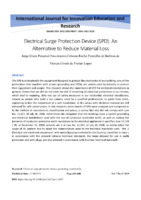 Electrical Surge Protection Device (SPD): An Alternative to Reduce Material Loss
Electrical Surge Protection Device (SPD): An Alternative to Reduce Material Loss Abstract
The SPD is undoubtedly the equipment designed to protect the electronics of any building, one of the
protections that together with proper grounding and SPDA, are widely used by industry to protect
their equipment and people. This research shows the importance of SPD for electrical installations in
general, shows that we still do not have the risk of encircling all electrical protections in our homes,
which lead to inquiring. Why not use all safety measures in our residential electrical installations,
viewed as people who build a bus camera rated by a qualified professional, to guide their client,
explaining to him the importance of a safe installation, ie the values with electrical material are still
elevated for safe construction. In this research, some brands of SPD were analyzed and compared as
to the method of manufacture, classification and prices, a survey that also did not comply with Law
No. 11,337, of July 26, 2006. Determines the obligation that the buildings have a system grounding
and electrical installations used with the use of conductor protective earth, as well as making the
presence of conductor protective earth mandatory in the electrical appliances it specifies. Law 12,119
/ 09, of December 15, 2009, amends art. 2 of Law No. 11,337, of July 26, 2006, to better detail the
scope of its content and to adapt the nomenclature used to the technical standards used. "Art. 2
Electrical and electronic equipment, with metal housing marketed in the Country, classified in class I,
in accordance with the relevant national technical standards, the items allowed for use in earth
protection and with plugs, are also allowed in accordance with Brazilian technical standards.
Keyword: Electrical surge protection device, grounding, cost-benefit;
-
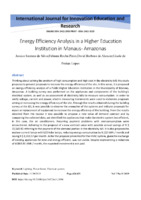 Energy Efficiency Analysis in a Higher Education Institution in Manaus - Amazonas
Energy Efficiency Analysis in a Higher Education Institution in Manaus - Amazonas Abstract
Thinking about solving the problem of high consumption and high cost in the electricity bill, this study
proposes to present proposals to increase the energy efficiency of the site. In this sense, it is proposed
an energy efficiency analysis of a Public Higher Education Institution in the Municipality of Manaus,
Amazonas. A building survey was performed on the appliances and components of the building's
electrical system, as well as an assessment of electricity bills to measure consumption. In order to
verify voltage, current and power, electric measuring instruments were used to elaborate proposals
aiming at increasing the energy efficiency of the site. Through the results obtained during the building
survey at the IES, it was possible to observe the anomalies of the systems and indicate proposals for
repair or replacement of equipment to increase the energy efficiency of the building. From the results
obtained from the invoice it was possible to propose a new value of demand contract and by
comparing the collected data, we identified the appliances that make the electric system less efficient,
in this case, the air conditioners. Recurring payment problems with overconsumption were
encountered. Adhering to the proposal of a new contract value with possible annual savings of R $
22,543.92 referring to the payment of the demand portion in the electricity bill. It is also proposed to
replace current lamps with LED tube lamps, reducing energy consumption by 9,122 kWh / month and
saving R $ 3,263.57 per month. As for the proposal presented for the HVAC system, given the exchange
of existing appliances for new and energy efficient, was not viable. Despite representing a reduction
of 41869.91 kWh / month, the expected investment is not paid.
Keyword: Lighting, Power factor, Electrical system;
-
 Evaluation of the Basic Sanitation Legislative System in Manaus - Amazonas
Evaluation of the Basic Sanitation Legislative System in Manaus - Amazonas Abstract
This study dealt with the legislative system of basic sanitation in the city of Manaus. From this approach
we sought to develop the research from the parameters of the Brazilian legislation related to the basic
sanitation sector, as well as to identify the important conducts on sustainable development.
Understanding the importance of the subject in evidence, it is worth mentioning that Brazil has a
considerable volume of freshwater in the world, and likewise, the Amazon has in its watershed much
of that water in its rivers. Therefore, the objective of this investigation was to analyze the legislative
system of basic sanitation of the city of Manaus - Amazonas, in order to understand the actions
developed by this system. For the construction of this study, the methodology adopted was the
bibliographic research with a qualitative approach, in order to reach the proposed objectives.
Regarding the legislation that deals with basic sanitation, many advances in the sector were obtained.
Most of the population does not have access to basic sanitation services, even if provided for by
Brazilian law.
Keyword: Basic sanitation; Sustainable development; Basic sanitation legislative system;
-
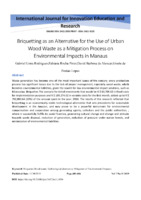 Briquetting as an Alternative for the Use of Urban Wood Waste as a Mitigation Process on Environmental Impacts in Manaus
Briquetting as an Alternative for the Use of Urban Wood Waste as a Mitigation Process on Environmental Impacts in Manaus Abstract
Waste generation has become one of the most important issues of the century, every production
process has significant losses due to the lack of proper management, especially wood waste, which
becomes environmental liabilities, given the search for low environmental impact solutions, such as
Microusina. Briquettes The scenario for initial investments that would be R $ 63,706.62 in fixed costs
for implementation purposes and R $ 109,274.02 in variable costs for the first month, added up to R $
792,980.64 (20%) of the amount spent in the year. 2018. The results of this research reflected that
briquetting is an economically viable technological alternative that sets precedents for sustainable
development in the Amazon, and may prove to be a powerful instrument for environmental
compensation and cooperation among generating agents, collectors and the public authorities. ,
where it successfully fulfills its social function, generating cultural change and change and attitude
towards waste disposal, reduction of generation, reduction of pressure under native forests, and
minimization of environmental liabilities.
Keyword: Briquettes Wood waste; Technological alternative; Mitigation of Environmental Impacts;
-
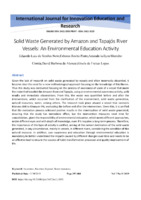 Solid Waste Generated by Amazon and Tapajós River Vessels: An Environmental Education Activity
Solid Waste Generated by Amazon and Tapajós River Vessels: An Environmental Education Activity Abstract
Given the lack of research on solid waste generated by vessels and often incorrectly discarded, it
became clear the need for a new methodological approach focusing on the knowledge of this theme.
Thus this study was conducted focusing on the process of awareness of users of a vessel that made
the route that traveled the Amazon River and Tapajós, using an environmental awareness activity, with
results and immediate observations. From this, the waste was quantified before and after the
interventions, which occurred from the clarification of the environment, solid waste generation,
natural resources, water, among others. The research took place aboard a vessel that connects
Manaus-AM to Alenquer-PA, evaluating the before and after the intervention. Given this, it is verified
that the evaluation process achieved positive results in the minimization of solid waste generated,
ensuring that the study has immediate effect, but the intervention measures need time for
consolidation, given the responsibility of environmental education, which needs different approaches,
under different eyes and with depth of knowledge, even if it requires a long-term process. Therefore,
the importance of this type of activity is verified, aiming at the correct destination of the solid waste
generated, in any circumstance, mainly in vessels, in different rivers, considering the condition of this
natural resource. In addition, user awareness and education through environmental education is
mandatory to better understand the impacts caused by different changes over time and needs to be
an effective tool to ensure the success of habit transformation processes and quality improvement of
life.
Keyword: Awareness; Incorrect disposal; Water resources;
-
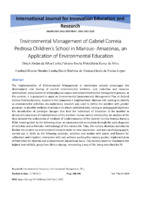 Environmental Management of Gabriel Correia Pedrosa Children's School in Manaus - Amazonas, an Application of Environmental Education
Environmental Management of Gabriel Correia Pedrosa Children's School in Manaus - Amazonas, an Application of Environmental Education Abstract
The implementation of Environmental Management in elementary schools encourages the
development and sharing of correct environmental solutions, cost reduction and resource
optimization, conservation of school physical spaces and commitment to the management process. In
this context, it is proposed to apply an Environmental Environmental Management Plan at Gabriel
Correia Pedrosa Nursery, located in the Compensa II neighborhood, Manaus-AM, seeking to identify
as environmental activities. An exploratory research was used to define the problem with greater
precision, to identify methods of action or to obtain additional data, having as pedagogical objectives
the introduction of paradigm changes that lead the individuals of Education to be inserted in
democratic processes of transformation of the problem. human-nature relationship. An analysis of the
data allowed the elaboration of methods of implementation of the Gabriel Correia Pedrosa Nursery
PGAE model guided by the following steps: an environmental perception through the early diagnosis
of activities and a thematic methodology of the nursery EA. Thus, the nursery develops activities to
finalize the student on environmental issues in order to raise awareness - and use a multiplying agent,
carried out in 2019, as the following activities: activities and studies with plants and flowers for
cultivation and irrigation; interaction with soil, without working the nursery garden; implementation
of fruit trees for children and environmental educational tours. The Nursery seeks to implement the
highest level of GEA, going from 5R to a change, reinventing a way of life, being described by 7R.
Keyword: Environmental Education, Environmental Management, 7R's;
-
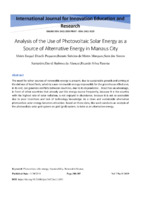 Analysis of the Use of Photovoltaic Solar Energy as a Source of Alternative Energy in Manaus City
Analysis of the Use of Photovoltaic Solar Energy as a Source of Alternative Energy in Manaus City Abstract
The need for other sources of renewable energy is present, due to sustainable growth and aiming at
the dull use of fossil fuels, which is a non-renewable energy responsible for the greenhouse effect and,
in its end, can generate conflicts between countries, due to its dependence. . Brazil has an advantage,
in front of other countries that already use this energy source frequently, because it is the country
with the highest rate of solar radiation, is not enjoyed in abundance, because it is not so accessible
due to poor incentives and lack of technology knowledge. As a clean and sustainable alternative
photovoltaic solar energy becomes attractive. Based on these data, this work conducts an analysis of
the photovoltaic solar grid system on grid (grid) system, to take as an alternative energy.
Keyword: Photovoltaic solar energy. Sustainability. Renewable Source;
-
 Work Safety Management for Optimization Production Process
Work Safety Management for Optimization Production Process Abstract
The safety at work of employees is not always viewed with due importance. However, with the help
of technology, such as E-social, the government system that organizes companies to communicate in
a unified way as information for their employees, it executes with whom employers comply with strict
safety standards. The main objective of this article is to demonstrate that occupational safety
management improves accident rates in the company through actions on enforcement methods that
are the basic causes of accidents. What's more, quality, management, costs and other values are better
through behavioral changes. Within the Thematic service, we seek or develop conscientious and
motivated employees, as a safe environment must be in place to support safe working employees.
Therefore, after the implant or safety management system, you can reduce a satisfactory reduction of
work accidents and get good results in the production process.
Keyword: Safety Management, Work Accident, Accident Index, Productive Process.
-
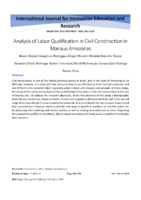 Analysis of Labor Qualification in Civil Construction in Manaus Amazonas
Analysis of Labor Qualification in Civil Construction in Manaus Amazonas Abstract
Civil construction is one of the fastest growing sectors in Brazil, and in the state of Amazonas is no
different, however, it is observed that several problems are affected by direct formal companies and
one of them is the unskilled labor, especially when It deals with masons and servants, in these terms,
the study of this study and analysis of the qualification of the labor in the civil construction in the city
of Manaus-Am. To achieve the research objectives, in the first moment of this study a bibliographic
research was carried out, based on books, articles and magazines already published, and in the second
stage field research and it is also a qualitative research. And according to the two surveys, it was found
that construction in Manaus needs to look for new ways to qualify its workers, so that the sector can
be producing their buildings with better quality, as well as making their deliveries on time. Regarding
the proposal to qualify the workforce, the surveyed companies will study a way to perform training for
their workers.
Keyword: Construction; Labor; Manaus; Qualification;
-
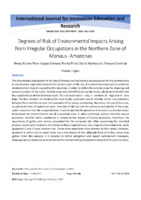 Degrees of Risk of Environmental Impacts Arising from Irregular Occupations in the Northern Zone of Manaus - Amazonas
Degrees of Risk of Environmental Impacts Arising from Irregular Occupations in the Northern Zone of Manaus - Amazonas Abstract
The disordered urban growth in the city of Manaus has had serious consequences for the environment
in recent years, especially towards the northern part of the city. It is extremely important to verify the
environmental impacts caused by this situation, in order to define the priority areas for planning and
recovery actions of the areas. Sixteen areas were identified during the study, which were divided into
four quadrants to define their risk levels. The risk levels were I - low, II - medium, III - high and IV - very
high. The first criterion for dividing the areas in the quadrants was to identify similar characteristics
between them and the second, the proximity of the areas, considering, therefore, the size of the area,
as well as the loss of vegetation cover, the state of the soil and the existence and quality of the areas.
water resources near the occupied areas. It was found that the presence of streams is a decisive factor
to increase the environmental risk of a occupied area, in which anthropic actions intensify natural
processes. Another factor considered is related to the degree of erosive processes, therefore, the
occurrence of gullies and ravines accounted for the increased risk. After accounting for recorded
impacts, quadrant B, located in the Cidade de Deus neighborhood, has a high environmental risk, while
quadrants C and D have medium risk. These three quadrants have streams in their areas, however,
quadrant A, which has no water body, has a low degree of risk, although three of its four areas have
gullies. From this analysis, it is possible to define mitigation and impact containment measures,
allowing natural resources to be preserved for the well-being of everyone today and for years to come.
Keyword: Urban growth; Risk areas; Environmental variables
-
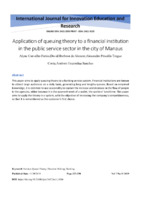 Application of queuing theory to a financial institution in the public service sector in the city of Manaus
Application of queuing theory to a financial institution in the public service sector in the city of Manaus Abstract
This paper aims to apply queuing theory to a banking service system. Financial institutions are known
to attract large audiences on a daily basis, generating long and lengthy queues. Based on empirical
knowledge, it is common to use seasonality to explain the increase and decrease in the flow of people
in the agencies, either because it is the payment week of a wallet, the workers' lunchtime. This paper
aims to apply the theory in a system, with the objective of increasing the company's competitiveness,
so that it is remembered as the customer's first choice.
Keyword: Service; Queue Theory; Decision Making; Banking.
-
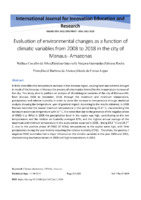 Evaluation of environmental changes as a function of climatic variables from 2008 to 2018 in the city of Manaus - Amazonas
Evaluation of environmental changes as a function of climatic variables from 2008 to 2018 in the city of Manaus - Amazonas Abstract
El Niño intensifies the temperature increase in the Amazon region, causing heat and extreme drought
in much of the Amazon, in Manaus the process of urbanization intensifies the temperature increase of
the city. This study aims to perform an analysis of climatological variables of the city of Manaus-AM,
from January 2008 to December 2018, through the maximum and minimum temperature,
precipitation and relative humidity in order to show the increase in temperature through statistical
analysis showing the temperature. year of greatest impact. According to the results obtained, in 2008
Manaus recorded the lowest minimum temperature in the period being 23.4 ° C, characterizing the
minimum maximum temperature with 32 ° C, it is noted that due to the presence of the negative phase
of ENSO ( La Niña) in 2008 the precipitation level in the region was high, contributing to the low
temperatures and the relative air humidity averaged 87%, and the highest annual average of the
maximum and minimum temperature in the study period occurred in 2015. , being 33.5 ° C and 25.7 °
C, due to the positive phase of ENSO (El Niño), temperatures in the capital were high, with little
precipitation during the year directly impacting the relative humidity (75%). . Therefore, the positive /
negative ENSO anomalies had a major influence on the climatic variables in the year 2008 and 2015,
characterizing low temperatures in 2008 and high temperatures in 2015.
Keyword: Climate phenomena, El Niño, Amazon.
-
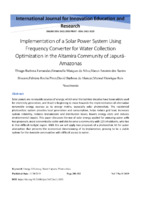 Implementation of a Solar Power System Using Frequency Converter for Water Collection Optimization in the Altamira Community of Japurá - Amazonas
Implementation of a Solar Power System Using Frequency Converter for Water Collection Optimization in the Altamira Community of Japurá - Amazonas Abstract
Solar panels are renewable sources of energy, which over the last two decades have been widely used
for electricity generation, and Brazil is beginning to move towards the implementation of alternative
renewable energy sources as its energy matrix, especially solar photovoltaic. The residential
photovoltaic system provides local generation and consumption, helps reduce grid load, increases
system reliability, reduces transmission and distribution losses, lowers energy costs and reduces
environmental impact. This paper discusses the use of solar energy applied for pumping water with
two proposals, most economically viable and able to serve a community with 123 inhabitants, who live
in that difficult-to-light region. With this we will apply two proposals of a photovoltaic kit for water
abstraction that presents the economical dimensioning of its implantation, proving to be a viable
system for the riverside communities with difficult access to water.
Keyword: Energy Efficiency, Water Capture, Photovoltaic.
-
 Strategic Planning Applied to Small Businesses: A Case Study in Maués - Amazonas
Strategic Planning Applied to Small Businesses: A Case Study in Maués - Amazonas Abstract
This paper aims to present the application of strategic planning for small companies and the tools that
help their development in the context of production engineering. Since strategic planning and tools
such as SWOT analysis, GUT matrix, brainstorming and 5W2H are of great importance in the business
environment, especially in the current economic situation, where companies need to have a
differential to stay in a highly competitive market. competitive. This makes the use of methods and
tools indispensable, as it is through them that the company can clearly and objectively gain insight into
its strengths, weaknesses, opportunities and threats, as well as develop an action plan to defined
strategies ensuring greater productivity.
Keyword: strategic planning, small business, action plan, production engineering.
-
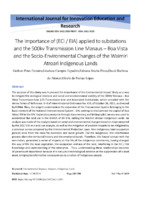 The Importance of (ECI / EIA) applied to substations and the 500kv Transmission Line Manaus – Boa Vista and the Socio-Environmental Changes of the Waimiri Atroari Indigenous Lands
The Importance of (ECI / EIA) applied to substations and the 500kv Transmission Line Manaus – Boa Vista and the Socio-Environmental Changes of the Waimiri Atroari Indigenous Lands Abstract
The purpose of this study was to present the importance of the Environmental Impact Study as a way
to mitigate the ecological relations and social and environmental viability of the 500kV Manaus - Boa
Vista Transmission Line (LT) Transmission Line and Associated Substations, which complied with the
Annex Terms of Reference. III-B of Interministerial Ordinance No. 419, of October 26, 2011, as directed
by FUNAI. Thus, the project contemplates the expansion of the Transmission System belonging to the
basic network of the National Interconnected System - SIN, seeking to interconnect the capital of Boa
Vista / RR to the SIN. Exploratory research through documentary and bibliographic survey was used to
understand the land use in the stretch of BR-174, cutting the Waimiri Atroari Indigenous Lands. An
analysis was made of the analysis based on social and environmental changes based on maps prepared
by the ECI / EIA as a land use analysis, as well as the mitigation of possible impacts to be mitigated by
a previous survey proposed by the Environmental Protection Laws. Non-indigenous land occupation
policies arise from the need for economic and social growth. For the indigenous, this interference
process alters the territorial history and the emotional bonds. Therefore, this forced contact with the
non-Indian, generated a series of impacts on the life of the indigenous community, having changed
the way of life the local vegetation, the occupation and use of the land, interfering in the ECI / EIA
knowledge and understanding of this enterprise. . Thus, understanding these relationships becomes
of paramount importance because it is not just a technological advance or the suppression of a local
need, bringing transformative consequences to a nation of indigenous people.
Keyword: Environmental Impacts, Amazon, Indigenous Land.
-
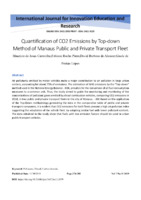 Quantification of CO2 Emissions by Top-down Method of Manaus Public and Private Transport Fleet
Quantification of CO2 Emissions by Top-down Method of Manaus Public and Private Transport Fleet Abstract
Air pollutants emitted by motor vehicles make a major contribution to air pollution in large urban
centers, accounting for about 75% of emissions. The estimation of GHG emissions by the “Top-down”
method used in the National Energy Balance - BEN, provides for the conversion of all fuel consumption
measures to a common unit. Thus, the study aimed to guide the monitoring and monitoring of the
concentrations of pollutant gases emitted by diesel combustion vehicles, comparing CO2 emissions in
2018, in two public and private transport fleets in the city of Manaus. - AM Based on the application
of the Top-Down methodology generating the data in the comparative table of public and private
transport companies, it is evident that CO2 emissions for both fleets present a high air pollution index
suggesting the adaptation of the vehicle fleet. by adopting similar fuel with lower pollutant content.
The data obtained in the study show that fuels with low emission factors should be used in urban
public transport vehicles.
Keyword: Pollutants; Diesel; Carbon dioxide.
-
 The Socioeconomic Impact of Paralyzed Public Works: Analysis on the University City of the State of Amazonas
The Socioeconomic Impact of Paralyzed Public Works: Analysis on the University City of the State of Amazonas Abstract
The presente research refers to the analysis of the socioeconomic impacts caused by the stoppage
of the University City of the State University of Amazonas in the Community Our Lady of Nazareth Lake
Test with the objective of investigating the consequences of not observing the principle of efficiency
in execution of the work of the University City by its managers, verifying the curret socioeconomic
situation of this local population, and finally propose ways to mitigate problems and losses resulting
from the stoppage, which is a matter of common interest as it covers all social classes. The research
approach is quantitative because it intends to describe a phenomenon of a particular group or Society,
its research instrument was the interview. To be eficiente during the execution of a work, it is
necessary to have management during the process, so the Executive Branch has instituted laws fo the
public Works to be managed efficiently, namely: the Growth Acceleration Program (PAC), instituted
by the Decree n° 6.025/2007; the DifferentialContracting Regime (RDC), launched by Law nº
12.462/2011; and the Bidding Law, introduced by Law n° 8.666/1993. These measures sought to
reduce delas and stoppages in public Works and the social and economic impacts that might be
generated.
Keyword: Socioeconomic impacts, Public Works, Principle of efficiency;
-
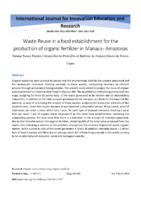 Waste Reuse in a food establishment for the production of organic fertilizer in Manaus - Amazonas
Waste Reuse in a food establishment for the production of organic fertilizer in Manaus - Amazonas Abstract
Organic waste has been a threat to society and the environment, both by the amount generated and
the inadequate treatment. Seeking solutions to these wastes, composting becomes an efficient
process through accelerated biodegradation. The present study aimed to analyze the reuse of organic
waste generated in a food establishment in Manaus-AM. The quantitative methodology presented two
steps, weighing for three (3) weeks daily, (i) the waste generated in the kitchen and (ii) discarded by
consumers, in addition to the total compost generated by the compost, as a basis for treatment of this
material, as way of minimizing the amount of these wastes, analyzing the productive activities of this
establishment. Given the results obtained it was observed a disposal of almost 30 kg / week, which if
estimated, can reach a value of 0.5 tons / year, for each type of disposal evaluated, totaling a value
that can reach 1 ton of organic waste disposed of by this small food establishment. Analyzing the
composting process, the data show that there is a reduction in the amount of materials generated,
due to their transformation into organic fertilizer, obtaining 50% of the total value produced from the
waste, thus indicating a solution to the problems arising from the incorrect disposal of waste. organic
matter, which is close to 54% of this waste generated in Brazil. In addition, currently about 1.3 billion
tons of food is wasted and there are on average about 815 million hungry people in the world, proving
to be an alternative of economic, social and ecological viability.
Keyword: Organic waste, Composting, Organic fertilizer;
-
 Rainwater Use in the FAMETRO Manacapuru Unit for Non-Potable Purposes
Rainwater Use in the FAMETRO Manacapuru Unit for Non-Potable Purposes Abstract
Water is the fundamental element for the existence of life on earth is one of the essential natural
resources used by humans. The use of alternative sources of water in public and private bodies has
been the most constant form in recent years, this time aiming to reduce the demand for drinking
water. The management of water use and the search for alternative sources of supply such as
rainwater use fall within the context of sustainable development, which proposes the use of natural
resources in a balanced way and without harming future generations. Thus, the design of the reservoir
for the use of rainwater at the Manacapuru Metropolitan Faculty of Manacapuru - UEA, by the
methods provided by the NBR 15527/2007 guidelines were satisfactory. With ten-year rainfall data
from 04/2008 to 12/2017, in the municipality of Manacapuru, the volume found for the reservoir to
meet the analyzed rainwater demand was 37.17 m³, with a supply of approximately 80% of nonpotable water consumption at Manaus Metropolitan Faculty Manacapuru unit. Thus the economic
advantages, the implementation of this sustainable system can bring benefits to the environment, so
all the water collected will help to minimize the occurrence of floods and the improper consumption
of treated water.
Keyword: Rainwater, reuse of water, Use of rainwater;
-
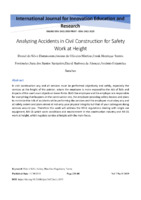 Analyzing Accidents in Civil Construction for Safety Work at Height
Analyzing Accidents in Civil Construction for Safety Work at Height Abstract
In civil construction any and all services must be performed objectively and safely, especially the
services at the height of the painter, where the employee is more exposed to the risk of falls and
impacts of the user's own objects on lower limbs. Both the employee and the employer are responsible
for everything that happens at the construction site, the employer providing safety devices and plans
to minimize the rich of accidents while performing the services and the employee must obey any and
all safety orders and plans aimed at not only your physical integrity but that of your colleagues doing
services around you. Therefore this work will address the NR-6 regulations dealing with single use
equipment, NR-18 which work conditions and environment in the construction industry and NR-35
work at height, which regulate service at height with the main focus
Keyword: Risk of falls; Safety; Brazilian Regulatory Norm;
 5G Technology Analysis in Relation to Electromagnetic Waves Abstract Electromagnetic waves are present in most of the main equipment used by humans. The advancement of 5G mobile network technology has been gaining ground in the telecommunications market and with it both positive and potentially negative consequences as it is used. Fundamental research has been conducted to gain knowledge and familiarity with 5G technology, how it works and its millimeter waves, which is a new range of the electromagnetic spectrum, which works with this new very high frequency and the first time used in technology. mobile network, as well as exploratory research through techniques such as bibliographic surveys in search of data such as frequency, related to 5G and the equipment transmitting electromagnetic waves, and conducting a comparative study to determine through the data collected from both , pointing out studies that present the evils that may cause the human being due to the use of high frequency. According to the results obtained on the 5G, the use of mobile network frequency presents no risks compared to other equipment that humans have been using. Therefore, despite the research results, it is still too early to point out possible damage over the years with the use of this technology, not ruling out possible consequences. Keyword: 5G; Electromagnetic waves; Millimeter waves; Mobile Network;
5G Technology Analysis in Relation to Electromagnetic Waves Abstract Electromagnetic waves are present in most of the main equipment used by humans. The advancement of 5G mobile network technology has been gaining ground in the telecommunications market and with it both positive and potentially negative consequences as it is used. Fundamental research has been conducted to gain knowledge and familiarity with 5G technology, how it works and its millimeter waves, which is a new range of the electromagnetic spectrum, which works with this new very high frequency and the first time used in technology. mobile network, as well as exploratory research through techniques such as bibliographic surveys in search of data such as frequency, related to 5G and the equipment transmitting electromagnetic waves, and conducting a comparative study to determine through the data collected from both , pointing out studies that present the evils that may cause the human being due to the use of high frequency. According to the results obtained on the 5G, the use of mobile network frequency presents no risks compared to other equipment that humans have been using. Therefore, despite the research results, it is still too early to point out possible damage over the years with the use of this technology, not ruling out possible consequences. Keyword: 5G; Electromagnetic waves; Millimeter waves; Mobile Network; Feasibility of Frying Oil After Treatment by a Biofuel Company in Manaus - Amazonas Abstract Waste generation has increased in many sectors given the demand and population growth. Reverse logistics comes to contribute to the return of these wastes to the production chain. In this context, frying oil is one of the most processed waste and transformed into new products, such as: biofuel, boiler fuel, soap manufacturing, concrete formwork release agent etc. Oil is one of the wastes whose recycling only happens by law, because it has low added value, unlike plastic, aluminum and copper, whose values are higher. The average oil consumption in Brazil reaches 3 billion liters per year, but only 2.5% of this total is recycled, the others are discarded in the wild. The aim of this study is to analyze Reverse Logistics at different points, seeking to describe the chain steps, from the final consumer, through the PEV and ending in the companies that will reuse the frying oil already treated. In Manaus, the logistics of frying oil is done by cooperatives and private companies, being MASSEG, the largest company in the segment. This research has an explanatory character, approaching a case study, which made it possible to observe the financial and environmental feasibility of reverse logistics for the collection of frying oil, carried out at Condomínio Shopping Manauara Center, in the city of Manaus, AM. To reverse this scenario, many companies are investing in the reverse logistics process. Procedures such as leaving drums empty so that they are filled with waste oil, separation of solid waste and water from oil, are already part of the routine of tenants that also contribute to non contamination of water bodies. The collection, transportation, filtering, decantation and commercialization of the product already treated, for fuel purposes, is performed by the company itself. Finally, the company uses part of the treated oil to manufacture biodiesel, applied to the consumption of its own fleet, with no commercialization of the generated biodiesel. Thus there is a reduction in the use and costs with usual fuels (fossils), seeking to add the culture of sustainability. Keyword: Reverse Logistics, Biodiesel, Waste.
Feasibility of Frying Oil After Treatment by a Biofuel Company in Manaus - Amazonas Abstract Waste generation has increased in many sectors given the demand and population growth. Reverse logistics comes to contribute to the return of these wastes to the production chain. In this context, frying oil is one of the most processed waste and transformed into new products, such as: biofuel, boiler fuel, soap manufacturing, concrete formwork release agent etc. Oil is one of the wastes whose recycling only happens by law, because it has low added value, unlike plastic, aluminum and copper, whose values are higher. The average oil consumption in Brazil reaches 3 billion liters per year, but only 2.5% of this total is recycled, the others are discarded in the wild. The aim of this study is to analyze Reverse Logistics at different points, seeking to describe the chain steps, from the final consumer, through the PEV and ending in the companies that will reuse the frying oil already treated. In Manaus, the logistics of frying oil is done by cooperatives and private companies, being MASSEG, the largest company in the segment. This research has an explanatory character, approaching a case study, which made it possible to observe the financial and environmental feasibility of reverse logistics for the collection of frying oil, carried out at Condomínio Shopping Manauara Center, in the city of Manaus, AM. To reverse this scenario, many companies are investing in the reverse logistics process. Procedures such as leaving drums empty so that they are filled with waste oil, separation of solid waste and water from oil, are already part of the routine of tenants that also contribute to non contamination of water bodies. The collection, transportation, filtering, decantation and commercialization of the product already treated, for fuel purposes, is performed by the company itself. Finally, the company uses part of the treated oil to manufacture biodiesel, applied to the consumption of its own fleet, with no commercialization of the generated biodiesel. Thus there is a reduction in the use and costs with usual fuels (fossils), seeking to add the culture of sustainability. Keyword: Reverse Logistics, Biodiesel, Waste. Piezoeletricity as an Alternative Source of Electric Power Generation in an Education Institution in the Amazon Abstract The development of technologies for the generation of clean and sustainable energy has brought significant changes to the energy sector in Brazil and worldwide. The newest technology is piezoelectricity, which although it has been studied for years, has not yet gained its proper space in the national and international electrical matrices. With this in mind, the present work aims to describe the process of installing a prototype carpet using piezoelectric ceramics that, through a force applied by any individual, is capable of generating enough energy for the operation of a turnstile in a HEI from Manaus-AM. The application was tested by modeling applying mathematical equations in the working of the prototype developed by APC International. Different answers were obtained considering the different dimensions for the piezoelectric parts. However, it is understood that this energy production model, treated as a new technology, presents economic viability in its implementation. One of the results demonstrates that the smaller the ceramic piece, the greater the energy production and can be adapted over time to respond to large productions. Thus, it is concluded from the calculations made that piezoelectric ceramics is an excellent alternative for the production of clean energy on a small scale, in a short time, and in the long term can reach large scale. Keyword: piezoelectric; sustainable energy, electric energy;
Piezoeletricity as an Alternative Source of Electric Power Generation in an Education Institution in the Amazon Abstract The development of technologies for the generation of clean and sustainable energy has brought significant changes to the energy sector in Brazil and worldwide. The newest technology is piezoelectricity, which although it has been studied for years, has not yet gained its proper space in the national and international electrical matrices. With this in mind, the present work aims to describe the process of installing a prototype carpet using piezoelectric ceramics that, through a force applied by any individual, is capable of generating enough energy for the operation of a turnstile in a HEI from Manaus-AM. The application was tested by modeling applying mathematical equations in the working of the prototype developed by APC International. Different answers were obtained considering the different dimensions for the piezoelectric parts. However, it is understood that this energy production model, treated as a new technology, presents economic viability in its implementation. One of the results demonstrates that the smaller the ceramic piece, the greater the energy production and can be adapted over time to respond to large productions. Thus, it is concluded from the calculations made that piezoelectric ceramics is an excellent alternative for the production of clean energy on a small scale, in a short time, and in the long term can reach large scale. Keyword: piezoelectric; sustainable energy, electric energy; Shared Economy: A Uber-Eats Case Study in Manaus City Abstract Given the prospective employment scenario that a society faces from the end of various areas due to various factors such as automation, new labor rights, lack or creation of new audiences, a shared economy caused in the midst of all this and It has become an option for the livelihood of many Manauaras. With the advancement of technology many changes occur in the way urban society uses its profits to generate income, it causes or disappears some professions, an interruption of others and the emergence of several. It was chosen to measure the data or the food delivery application that uber eats, which has about a year of use in Manaus, or even the concept of new forms of work organization, their deliverers, use modal and are directed to your destinations via GPS. This study sought to understand what is leading part of society to register in the application that is based on the shared economy. For such a survey, a quantitative survey was conducted in Manaus City to collect data required at high food ordering points per application, through a field survey, information was collected from various professionals. As a result of the investigation it was possible to map the professional profile of people who are choosing to work with this economic economy, and increase the incidence of technology for the lives of these professionals, it was possible to measure what challenges this new way of earning money provides, what are the advantages they bring, if it has the same advantages and the socio-economic impact on the day to day of professionals. Finally, it was carried out by the authors who conducted the survey, where after it was completed, it was possible to complete the applications associated with the shared economy that use yes, a great work alternative using technology as a medium. Keyword: Innovation, Shared Economy, Technology, Disruption;
Shared Economy: A Uber-Eats Case Study in Manaus City Abstract Given the prospective employment scenario that a society faces from the end of various areas due to various factors such as automation, new labor rights, lack or creation of new audiences, a shared economy caused in the midst of all this and It has become an option for the livelihood of many Manauaras. With the advancement of technology many changes occur in the way urban society uses its profits to generate income, it causes or disappears some professions, an interruption of others and the emergence of several. It was chosen to measure the data or the food delivery application that uber eats, which has about a year of use in Manaus, or even the concept of new forms of work organization, their deliverers, use modal and are directed to your destinations via GPS. This study sought to understand what is leading part of society to register in the application that is based on the shared economy. For such a survey, a quantitative survey was conducted in Manaus City to collect data required at high food ordering points per application, through a field survey, information was collected from various professionals. As a result of the investigation it was possible to map the professional profile of people who are choosing to work with this economic economy, and increase the incidence of technology for the lives of these professionals, it was possible to measure what challenges this new way of earning money provides, what are the advantages they bring, if it has the same advantages and the socio-economic impact on the day to day of professionals. Finally, it was carried out by the authors who conducted the survey, where after it was completed, it was possible to complete the applications associated with the shared economy that use yes, a great work alternative using technology as a medium. Keyword: Innovation, Shared Economy, Technology, Disruption; A Sustainability Analysis of Different Types of Asphalts Abstract The present work aimed to analyze ecological asphalts, aiming at their influence on the tripod of sustainability in the social, environmental and economic spheres. The option of using eco-rubber asphalt and EVA as a raw material for paving roads and highways is a bet for a more resistant material that requires less nature degradation and easier maintenance. One of the main reasons for the degradation of flexible pavement is the wear caused by the time of use, as well as the traffic of vehicles carrying excessive loads. This study reports some alternatives to multiply the improvement of reverse logistics of waste tires and EVA (ethyl vinyl acetate) plastics, facing problems related to environmental impacts, which directly affect the Brazilian population. This project is important because it is directly linked to sustainability and the development of the environment, facing renewable and suitable alternatives to be employed, such as ecological asphalts, and their benefits. Among the benefits of ecological asphalt we can mention the contribution to the environment by reducing the amount of waste tires improperly discarded in nature and the durability of ecological asphalt compared to conventional asphalt where it showed greater resistance to climate fatigue. The research used the qualitative method being a study based on bibliographies, analyze and discuss the reuse of solid waste and the mitigation of environmental impacts through asphalt. Ecological asphalt seems to be more expensive than the bituminous asphalt used today, however it is environmentally friendly and its effectiveness, durability and safety are noticeable advantages. Keyword: Sustainability tripod; paving; environmental impacts.
A Sustainability Analysis of Different Types of Asphalts Abstract The present work aimed to analyze ecological asphalts, aiming at their influence on the tripod of sustainability in the social, environmental and economic spheres. The option of using eco-rubber asphalt and EVA as a raw material for paving roads and highways is a bet for a more resistant material that requires less nature degradation and easier maintenance. One of the main reasons for the degradation of flexible pavement is the wear caused by the time of use, as well as the traffic of vehicles carrying excessive loads. This study reports some alternatives to multiply the improvement of reverse logistics of waste tires and EVA (ethyl vinyl acetate) plastics, facing problems related to environmental impacts, which directly affect the Brazilian population. This project is important because it is directly linked to sustainability and the development of the environment, facing renewable and suitable alternatives to be employed, such as ecological asphalts, and their benefits. Among the benefits of ecological asphalt we can mention the contribution to the environment by reducing the amount of waste tires improperly discarded in nature and the durability of ecological asphalt compared to conventional asphalt where it showed greater resistance to climate fatigue. The research used the qualitative method being a study based on bibliographies, analyze and discuss the reuse of solid waste and the mitigation of environmental impacts through asphalt. Ecological asphalt seems to be more expensive than the bituminous asphalt used today, however it is environmentally friendly and its effectiveness, durability and safety are noticeable advantages. Keyword: Sustainability tripod; paving; environmental impacts. Electrical Surge Protection Device (SPD): An Alternative to Reduce Material Loss Abstract The SPD is undoubtedly the equipment designed to protect the electronics of any building, one of the protections that together with proper grounding and SPDA, are widely used by industry to protect their equipment and people. This research shows the importance of SPD for electrical installations in general, shows that we still do not have the risk of encircling all electrical protections in our homes, which lead to inquiring. Why not use all safety measures in our residential electrical installations, viewed as people who build a bus camera rated by a qualified professional, to guide their client, explaining to him the importance of a safe installation, ie the values with electrical material are still elevated for safe construction. In this research, some brands of SPD were analyzed and compared as to the method of manufacture, classification and prices, a survey that also did not comply with Law No. 11,337, of July 26, 2006. Determines the obligation that the buildings have a system grounding and electrical installations used with the use of conductor protective earth, as well as making the presence of conductor protective earth mandatory in the electrical appliances it specifies. Law 12,119 / 09, of December 15, 2009, amends art. 2 of Law No. 11,337, of July 26, 2006, to better detail the scope of its content and to adapt the nomenclature used to the technical standards used. "Art. 2 Electrical and electronic equipment, with metal housing marketed in the Country, classified in class I, in accordance with the relevant national technical standards, the items allowed for use in earth protection and with plugs, are also allowed in accordance with Brazilian technical standards. Keyword: Electrical surge protection device, grounding, cost-benefit;
Electrical Surge Protection Device (SPD): An Alternative to Reduce Material Loss Abstract The SPD is undoubtedly the equipment designed to protect the electronics of any building, one of the protections that together with proper grounding and SPDA, are widely used by industry to protect their equipment and people. This research shows the importance of SPD for electrical installations in general, shows that we still do not have the risk of encircling all electrical protections in our homes, which lead to inquiring. Why not use all safety measures in our residential electrical installations, viewed as people who build a bus camera rated by a qualified professional, to guide their client, explaining to him the importance of a safe installation, ie the values with electrical material are still elevated for safe construction. In this research, some brands of SPD were analyzed and compared as to the method of manufacture, classification and prices, a survey that also did not comply with Law No. 11,337, of July 26, 2006. Determines the obligation that the buildings have a system grounding and electrical installations used with the use of conductor protective earth, as well as making the presence of conductor protective earth mandatory in the electrical appliances it specifies. Law 12,119 / 09, of December 15, 2009, amends art. 2 of Law No. 11,337, of July 26, 2006, to better detail the scope of its content and to adapt the nomenclature used to the technical standards used. "Art. 2 Electrical and electronic equipment, with metal housing marketed in the Country, classified in class I, in accordance with the relevant national technical standards, the items allowed for use in earth protection and with plugs, are also allowed in accordance with Brazilian technical standards. Keyword: Electrical surge protection device, grounding, cost-benefit; Energy Efficiency Analysis in a Higher Education Institution in Manaus - Amazonas Abstract Thinking about solving the problem of high consumption and high cost in the electricity bill, this study proposes to present proposals to increase the energy efficiency of the site. In this sense, it is proposed an energy efficiency analysis of a Public Higher Education Institution in the Municipality of Manaus, Amazonas. A building survey was performed on the appliances and components of the building's electrical system, as well as an assessment of electricity bills to measure consumption. In order to verify voltage, current and power, electric measuring instruments were used to elaborate proposals aiming at increasing the energy efficiency of the site. Through the results obtained during the building survey at the IES, it was possible to observe the anomalies of the systems and indicate proposals for repair or replacement of equipment to increase the energy efficiency of the building. From the results obtained from the invoice it was possible to propose a new value of demand contract and by comparing the collected data, we identified the appliances that make the electric system less efficient, in this case, the air conditioners. Recurring payment problems with overconsumption were encountered. Adhering to the proposal of a new contract value with possible annual savings of R $ 22,543.92 referring to the payment of the demand portion in the electricity bill. It is also proposed to replace current lamps with LED tube lamps, reducing energy consumption by 9,122 kWh / month and saving R $ 3,263.57 per month. As for the proposal presented for the HVAC system, given the exchange of existing appliances for new and energy efficient, was not viable. Despite representing a reduction of 41869.91 kWh / month, the expected investment is not paid. Keyword: Lighting, Power factor, Electrical system;
Energy Efficiency Analysis in a Higher Education Institution in Manaus - Amazonas Abstract Thinking about solving the problem of high consumption and high cost in the electricity bill, this study proposes to present proposals to increase the energy efficiency of the site. In this sense, it is proposed an energy efficiency analysis of a Public Higher Education Institution in the Municipality of Manaus, Amazonas. A building survey was performed on the appliances and components of the building's electrical system, as well as an assessment of electricity bills to measure consumption. In order to verify voltage, current and power, electric measuring instruments were used to elaborate proposals aiming at increasing the energy efficiency of the site. Through the results obtained during the building survey at the IES, it was possible to observe the anomalies of the systems and indicate proposals for repair or replacement of equipment to increase the energy efficiency of the building. From the results obtained from the invoice it was possible to propose a new value of demand contract and by comparing the collected data, we identified the appliances that make the electric system less efficient, in this case, the air conditioners. Recurring payment problems with overconsumption were encountered. Adhering to the proposal of a new contract value with possible annual savings of R $ 22,543.92 referring to the payment of the demand portion in the electricity bill. It is also proposed to replace current lamps with LED tube lamps, reducing energy consumption by 9,122 kWh / month and saving R $ 3,263.57 per month. As for the proposal presented for the HVAC system, given the exchange of existing appliances for new and energy efficient, was not viable. Despite representing a reduction of 41869.91 kWh / month, the expected investment is not paid. Keyword: Lighting, Power factor, Electrical system; Evaluation of the Basic Sanitation Legislative System in Manaus - Amazonas Abstract This study dealt with the legislative system of basic sanitation in the city of Manaus. From this approach we sought to develop the research from the parameters of the Brazilian legislation related to the basic sanitation sector, as well as to identify the important conducts on sustainable development. Understanding the importance of the subject in evidence, it is worth mentioning that Brazil has a considerable volume of freshwater in the world, and likewise, the Amazon has in its watershed much of that water in its rivers. Therefore, the objective of this investigation was to analyze the legislative system of basic sanitation of the city of Manaus - Amazonas, in order to understand the actions developed by this system. For the construction of this study, the methodology adopted was the bibliographic research with a qualitative approach, in order to reach the proposed objectives. Regarding the legislation that deals with basic sanitation, many advances in the sector were obtained. Most of the population does not have access to basic sanitation services, even if provided for by Brazilian law. Keyword: Basic sanitation; Sustainable development; Basic sanitation legislative system;
Evaluation of the Basic Sanitation Legislative System in Manaus - Amazonas Abstract This study dealt with the legislative system of basic sanitation in the city of Manaus. From this approach we sought to develop the research from the parameters of the Brazilian legislation related to the basic sanitation sector, as well as to identify the important conducts on sustainable development. Understanding the importance of the subject in evidence, it is worth mentioning that Brazil has a considerable volume of freshwater in the world, and likewise, the Amazon has in its watershed much of that water in its rivers. Therefore, the objective of this investigation was to analyze the legislative system of basic sanitation of the city of Manaus - Amazonas, in order to understand the actions developed by this system. For the construction of this study, the methodology adopted was the bibliographic research with a qualitative approach, in order to reach the proposed objectives. Regarding the legislation that deals with basic sanitation, many advances in the sector were obtained. Most of the population does not have access to basic sanitation services, even if provided for by Brazilian law. Keyword: Basic sanitation; Sustainable development; Basic sanitation legislative system; Briquetting as an Alternative for the Use of Urban Wood Waste as a Mitigation Process on Environmental Impacts in Manaus Abstract Waste generation has become one of the most important issues of the century, every production process has significant losses due to the lack of proper management, especially wood waste, which becomes environmental liabilities, given the search for low environmental impact solutions, such as Microusina. Briquettes The scenario for initial investments that would be R $ 63,706.62 in fixed costs for implementation purposes and R $ 109,274.02 in variable costs for the first month, added up to R $ 792,980.64 (20%) of the amount spent in the year. 2018. The results of this research reflected that briquetting is an economically viable technological alternative that sets precedents for sustainable development in the Amazon, and may prove to be a powerful instrument for environmental compensation and cooperation among generating agents, collectors and the public authorities. , where it successfully fulfills its social function, generating cultural change and change and attitude towards waste disposal, reduction of generation, reduction of pressure under native forests, and minimization of environmental liabilities. Keyword: Briquettes Wood waste; Technological alternative; Mitigation of Environmental Impacts;
Briquetting as an Alternative for the Use of Urban Wood Waste as a Mitigation Process on Environmental Impacts in Manaus Abstract Waste generation has become one of the most important issues of the century, every production process has significant losses due to the lack of proper management, especially wood waste, which becomes environmental liabilities, given the search for low environmental impact solutions, such as Microusina. Briquettes The scenario for initial investments that would be R $ 63,706.62 in fixed costs for implementation purposes and R $ 109,274.02 in variable costs for the first month, added up to R $ 792,980.64 (20%) of the amount spent in the year. 2018. The results of this research reflected that briquetting is an economically viable technological alternative that sets precedents for sustainable development in the Amazon, and may prove to be a powerful instrument for environmental compensation and cooperation among generating agents, collectors and the public authorities. , where it successfully fulfills its social function, generating cultural change and change and attitude towards waste disposal, reduction of generation, reduction of pressure under native forests, and minimization of environmental liabilities. Keyword: Briquettes Wood waste; Technological alternative; Mitigation of Environmental Impacts; Solid Waste Generated by Amazon and Tapajós River Vessels: An Environmental Education Activity Abstract Given the lack of research on solid waste generated by vessels and often incorrectly discarded, it became clear the need for a new methodological approach focusing on the knowledge of this theme. Thus this study was conducted focusing on the process of awareness of users of a vessel that made the route that traveled the Amazon River and Tapajós, using an environmental awareness activity, with results and immediate observations. From this, the waste was quantified before and after the interventions, which occurred from the clarification of the environment, solid waste generation, natural resources, water, among others. The research took place aboard a vessel that connects Manaus-AM to Alenquer-PA, evaluating the before and after the intervention. Given this, it is verified that the evaluation process achieved positive results in the minimization of solid waste generated, ensuring that the study has immediate effect, but the intervention measures need time for consolidation, given the responsibility of environmental education, which needs different approaches, under different eyes and with depth of knowledge, even if it requires a long-term process. Therefore, the importance of this type of activity is verified, aiming at the correct destination of the solid waste generated, in any circumstance, mainly in vessels, in different rivers, considering the condition of this natural resource. In addition, user awareness and education through environmental education is mandatory to better understand the impacts caused by different changes over time and needs to be an effective tool to ensure the success of habit transformation processes and quality improvement of life. Keyword: Awareness; Incorrect disposal; Water resources;
Solid Waste Generated by Amazon and Tapajós River Vessels: An Environmental Education Activity Abstract Given the lack of research on solid waste generated by vessels and often incorrectly discarded, it became clear the need for a new methodological approach focusing on the knowledge of this theme. Thus this study was conducted focusing on the process of awareness of users of a vessel that made the route that traveled the Amazon River and Tapajós, using an environmental awareness activity, with results and immediate observations. From this, the waste was quantified before and after the interventions, which occurred from the clarification of the environment, solid waste generation, natural resources, water, among others. The research took place aboard a vessel that connects Manaus-AM to Alenquer-PA, evaluating the before and after the intervention. Given this, it is verified that the evaluation process achieved positive results in the minimization of solid waste generated, ensuring that the study has immediate effect, but the intervention measures need time for consolidation, given the responsibility of environmental education, which needs different approaches, under different eyes and with depth of knowledge, even if it requires a long-term process. Therefore, the importance of this type of activity is verified, aiming at the correct destination of the solid waste generated, in any circumstance, mainly in vessels, in different rivers, considering the condition of this natural resource. In addition, user awareness and education through environmental education is mandatory to better understand the impacts caused by different changes over time and needs to be an effective tool to ensure the success of habit transformation processes and quality improvement of life. Keyword: Awareness; Incorrect disposal; Water resources; Environmental Management of Gabriel Correia Pedrosa Children's School in Manaus - Amazonas, an Application of Environmental Education Abstract The implementation of Environmental Management in elementary schools encourages the development and sharing of correct environmental solutions, cost reduction and resource optimization, conservation of school physical spaces and commitment to the management process. In this context, it is proposed to apply an Environmental Environmental Management Plan at Gabriel Correia Pedrosa Nursery, located in the Compensa II neighborhood, Manaus-AM, seeking to identify as environmental activities. An exploratory research was used to define the problem with greater precision, to identify methods of action or to obtain additional data, having as pedagogical objectives the introduction of paradigm changes that lead the individuals of Education to be inserted in democratic processes of transformation of the problem. human-nature relationship. An analysis of the data allowed the elaboration of methods of implementation of the Gabriel Correia Pedrosa Nursery PGAE model guided by the following steps: an environmental perception through the early diagnosis of activities and a thematic methodology of the nursery EA. Thus, the nursery develops activities to finalize the student on environmental issues in order to raise awareness - and use a multiplying agent, carried out in 2019, as the following activities: activities and studies with plants and flowers for cultivation and irrigation; interaction with soil, without working the nursery garden; implementation of fruit trees for children and environmental educational tours. The Nursery seeks to implement the highest level of GEA, going from 5R to a change, reinventing a way of life, being described by 7R. Keyword: Environmental Education, Environmental Management, 7R's;
Environmental Management of Gabriel Correia Pedrosa Children's School in Manaus - Amazonas, an Application of Environmental Education Abstract The implementation of Environmental Management in elementary schools encourages the development and sharing of correct environmental solutions, cost reduction and resource optimization, conservation of school physical spaces and commitment to the management process. In this context, it is proposed to apply an Environmental Environmental Management Plan at Gabriel Correia Pedrosa Nursery, located in the Compensa II neighborhood, Manaus-AM, seeking to identify as environmental activities. An exploratory research was used to define the problem with greater precision, to identify methods of action or to obtain additional data, having as pedagogical objectives the introduction of paradigm changes that lead the individuals of Education to be inserted in democratic processes of transformation of the problem. human-nature relationship. An analysis of the data allowed the elaboration of methods of implementation of the Gabriel Correia Pedrosa Nursery PGAE model guided by the following steps: an environmental perception through the early diagnosis of activities and a thematic methodology of the nursery EA. Thus, the nursery develops activities to finalize the student on environmental issues in order to raise awareness - and use a multiplying agent, carried out in 2019, as the following activities: activities and studies with plants and flowers for cultivation and irrigation; interaction with soil, without working the nursery garden; implementation of fruit trees for children and environmental educational tours. The Nursery seeks to implement the highest level of GEA, going from 5R to a change, reinventing a way of life, being described by 7R. Keyword: Environmental Education, Environmental Management, 7R's; Analysis of the Use of Photovoltaic Solar Energy as a Source of Alternative Energy in Manaus City Abstract The need for other sources of renewable energy is present, due to sustainable growth and aiming at the dull use of fossil fuels, which is a non-renewable energy responsible for the greenhouse effect and, in its end, can generate conflicts between countries, due to its dependence. . Brazil has an advantage, in front of other countries that already use this energy source frequently, because it is the country with the highest rate of solar radiation, is not enjoyed in abundance, because it is not so accessible due to poor incentives and lack of technology knowledge. As a clean and sustainable alternative photovoltaic solar energy becomes attractive. Based on these data, this work conducts an analysis of the photovoltaic solar grid system on grid (grid) system, to take as an alternative energy. Keyword: Photovoltaic solar energy. Sustainability. Renewable Source;
Analysis of the Use of Photovoltaic Solar Energy as a Source of Alternative Energy in Manaus City Abstract The need for other sources of renewable energy is present, due to sustainable growth and aiming at the dull use of fossil fuels, which is a non-renewable energy responsible for the greenhouse effect and, in its end, can generate conflicts between countries, due to its dependence. . Brazil has an advantage, in front of other countries that already use this energy source frequently, because it is the country with the highest rate of solar radiation, is not enjoyed in abundance, because it is not so accessible due to poor incentives and lack of technology knowledge. As a clean and sustainable alternative photovoltaic solar energy becomes attractive. Based on these data, this work conducts an analysis of the photovoltaic solar grid system on grid (grid) system, to take as an alternative energy. Keyword: Photovoltaic solar energy. Sustainability. Renewable Source; Work Safety Management for Optimization Production Process Abstract The safety at work of employees is not always viewed with due importance. However, with the help of technology, such as E-social, the government system that organizes companies to communicate in a unified way as information for their employees, it executes with whom employers comply with strict safety standards. The main objective of this article is to demonstrate that occupational safety management improves accident rates in the company through actions on enforcement methods that are the basic causes of accidents. What's more, quality, management, costs and other values are better through behavioral changes. Within the Thematic service, we seek or develop conscientious and motivated employees, as a safe environment must be in place to support safe working employees. Therefore, after the implant or safety management system, you can reduce a satisfactory reduction of work accidents and get good results in the production process. Keyword: Safety Management, Work Accident, Accident Index, Productive Process.
Work Safety Management for Optimization Production Process Abstract The safety at work of employees is not always viewed with due importance. However, with the help of technology, such as E-social, the government system that organizes companies to communicate in a unified way as information for their employees, it executes with whom employers comply with strict safety standards. The main objective of this article is to demonstrate that occupational safety management improves accident rates in the company through actions on enforcement methods that are the basic causes of accidents. What's more, quality, management, costs and other values are better through behavioral changes. Within the Thematic service, we seek or develop conscientious and motivated employees, as a safe environment must be in place to support safe working employees. Therefore, after the implant or safety management system, you can reduce a satisfactory reduction of work accidents and get good results in the production process. Keyword: Safety Management, Work Accident, Accident Index, Productive Process. Analysis of Labor Qualification in Civil Construction in Manaus Amazonas Abstract Civil construction is one of the fastest growing sectors in Brazil, and in the state of Amazonas is no different, however, it is observed that several problems are affected by direct formal companies and one of them is the unskilled labor, especially when It deals with masons and servants, in these terms, the study of this study and analysis of the qualification of the labor in the civil construction in the city of Manaus-Am. To achieve the research objectives, in the first moment of this study a bibliographic research was carried out, based on books, articles and magazines already published, and in the second stage field research and it is also a qualitative research. And according to the two surveys, it was found that construction in Manaus needs to look for new ways to qualify its workers, so that the sector can be producing their buildings with better quality, as well as making their deliveries on time. Regarding the proposal to qualify the workforce, the surveyed companies will study a way to perform training for their workers. Keyword: Construction; Labor; Manaus; Qualification;
Analysis of Labor Qualification in Civil Construction in Manaus Amazonas Abstract Civil construction is one of the fastest growing sectors in Brazil, and in the state of Amazonas is no different, however, it is observed that several problems are affected by direct formal companies and one of them is the unskilled labor, especially when It deals with masons and servants, in these terms, the study of this study and analysis of the qualification of the labor in the civil construction in the city of Manaus-Am. To achieve the research objectives, in the first moment of this study a bibliographic research was carried out, based on books, articles and magazines already published, and in the second stage field research and it is also a qualitative research. And according to the two surveys, it was found that construction in Manaus needs to look for new ways to qualify its workers, so that the sector can be producing their buildings with better quality, as well as making their deliveries on time. Regarding the proposal to qualify the workforce, the surveyed companies will study a way to perform training for their workers. Keyword: Construction; Labor; Manaus; Qualification; Degrees of Risk of Environmental Impacts Arising from Irregular Occupations in the Northern Zone of Manaus - Amazonas Abstract The disordered urban growth in the city of Manaus has had serious consequences for the environment in recent years, especially towards the northern part of the city. It is extremely important to verify the environmental impacts caused by this situation, in order to define the priority areas for planning and recovery actions of the areas. Sixteen areas were identified during the study, which were divided into four quadrants to define their risk levels. The risk levels were I - low, II - medium, III - high and IV - very high. The first criterion for dividing the areas in the quadrants was to identify similar characteristics between them and the second, the proximity of the areas, considering, therefore, the size of the area, as well as the loss of vegetation cover, the state of the soil and the existence and quality of the areas. water resources near the occupied areas. It was found that the presence of streams is a decisive factor to increase the environmental risk of a occupied area, in which anthropic actions intensify natural processes. Another factor considered is related to the degree of erosive processes, therefore, the occurrence of gullies and ravines accounted for the increased risk. After accounting for recorded impacts, quadrant B, located in the Cidade de Deus neighborhood, has a high environmental risk, while quadrants C and D have medium risk. These three quadrants have streams in their areas, however, quadrant A, which has no water body, has a low degree of risk, although three of its four areas have gullies. From this analysis, it is possible to define mitigation and impact containment measures, allowing natural resources to be preserved for the well-being of everyone today and for years to come. Keyword: Urban growth; Risk areas; Environmental variables
Degrees of Risk of Environmental Impacts Arising from Irregular Occupations in the Northern Zone of Manaus - Amazonas Abstract The disordered urban growth in the city of Manaus has had serious consequences for the environment in recent years, especially towards the northern part of the city. It is extremely important to verify the environmental impacts caused by this situation, in order to define the priority areas for planning and recovery actions of the areas. Sixteen areas were identified during the study, which were divided into four quadrants to define their risk levels. The risk levels were I - low, II - medium, III - high and IV - very high. The first criterion for dividing the areas in the quadrants was to identify similar characteristics between them and the second, the proximity of the areas, considering, therefore, the size of the area, as well as the loss of vegetation cover, the state of the soil and the existence and quality of the areas. water resources near the occupied areas. It was found that the presence of streams is a decisive factor to increase the environmental risk of a occupied area, in which anthropic actions intensify natural processes. Another factor considered is related to the degree of erosive processes, therefore, the occurrence of gullies and ravines accounted for the increased risk. After accounting for recorded impacts, quadrant B, located in the Cidade de Deus neighborhood, has a high environmental risk, while quadrants C and D have medium risk. These three quadrants have streams in their areas, however, quadrant A, which has no water body, has a low degree of risk, although three of its four areas have gullies. From this analysis, it is possible to define mitigation and impact containment measures, allowing natural resources to be preserved for the well-being of everyone today and for years to come. Keyword: Urban growth; Risk areas; Environmental variables Application of queuing theory to a financial institution in the public service sector in the city of Manaus Abstract This paper aims to apply queuing theory to a banking service system. Financial institutions are known to attract large audiences on a daily basis, generating long and lengthy queues. Based on empirical knowledge, it is common to use seasonality to explain the increase and decrease in the flow of people in the agencies, either because it is the payment week of a wallet, the workers' lunchtime. This paper aims to apply the theory in a system, with the objective of increasing the company's competitiveness, so that it is remembered as the customer's first choice. Keyword: Service; Queue Theory; Decision Making; Banking.
Application of queuing theory to a financial institution in the public service sector in the city of Manaus Abstract This paper aims to apply queuing theory to a banking service system. Financial institutions are known to attract large audiences on a daily basis, generating long and lengthy queues. Based on empirical knowledge, it is common to use seasonality to explain the increase and decrease in the flow of people in the agencies, either because it is the payment week of a wallet, the workers' lunchtime. This paper aims to apply the theory in a system, with the objective of increasing the company's competitiveness, so that it is remembered as the customer's first choice. Keyword: Service; Queue Theory; Decision Making; Banking. Evaluation of environmental changes as a function of climatic variables from 2008 to 2018 in the city of Manaus - Amazonas Abstract El Niño intensifies the temperature increase in the Amazon region, causing heat and extreme drought in much of the Amazon, in Manaus the process of urbanization intensifies the temperature increase of the city. This study aims to perform an analysis of climatological variables of the city of Manaus-AM, from January 2008 to December 2018, through the maximum and minimum temperature, precipitation and relative humidity in order to show the increase in temperature through statistical analysis showing the temperature. year of greatest impact. According to the results obtained, in 2008 Manaus recorded the lowest minimum temperature in the period being 23.4 ° C, characterizing the minimum maximum temperature with 32 ° C, it is noted that due to the presence of the negative phase of ENSO ( La Niña) in 2008 the precipitation level in the region was high, contributing to the low temperatures and the relative air humidity averaged 87%, and the highest annual average of the maximum and minimum temperature in the study period occurred in 2015. , being 33.5 ° C and 25.7 ° C, due to the positive phase of ENSO (El Niño), temperatures in the capital were high, with little precipitation during the year directly impacting the relative humidity (75%). . Therefore, the positive / negative ENSO anomalies had a major influence on the climatic variables in the year 2008 and 2015, characterizing low temperatures in 2008 and high temperatures in 2015. Keyword: Climate phenomena, El Niño, Amazon.
Evaluation of environmental changes as a function of climatic variables from 2008 to 2018 in the city of Manaus - Amazonas Abstract El Niño intensifies the temperature increase in the Amazon region, causing heat and extreme drought in much of the Amazon, in Manaus the process of urbanization intensifies the temperature increase of the city. This study aims to perform an analysis of climatological variables of the city of Manaus-AM, from January 2008 to December 2018, through the maximum and minimum temperature, precipitation and relative humidity in order to show the increase in temperature through statistical analysis showing the temperature. year of greatest impact. According to the results obtained, in 2008 Manaus recorded the lowest minimum temperature in the period being 23.4 ° C, characterizing the minimum maximum temperature with 32 ° C, it is noted that due to the presence of the negative phase of ENSO ( La Niña) in 2008 the precipitation level in the region was high, contributing to the low temperatures and the relative air humidity averaged 87%, and the highest annual average of the maximum and minimum temperature in the study period occurred in 2015. , being 33.5 ° C and 25.7 ° C, due to the positive phase of ENSO (El Niño), temperatures in the capital were high, with little precipitation during the year directly impacting the relative humidity (75%). . Therefore, the positive / negative ENSO anomalies had a major influence on the climatic variables in the year 2008 and 2015, characterizing low temperatures in 2008 and high temperatures in 2015. Keyword: Climate phenomena, El Niño, Amazon. Implementation of a Solar Power System Using Frequency Converter for Water Collection Optimization in the Altamira Community of Japurá - Amazonas Abstract Solar panels are renewable sources of energy, which over the last two decades have been widely used for electricity generation, and Brazil is beginning to move towards the implementation of alternative renewable energy sources as its energy matrix, especially solar photovoltaic. The residential photovoltaic system provides local generation and consumption, helps reduce grid load, increases system reliability, reduces transmission and distribution losses, lowers energy costs and reduces environmental impact. This paper discusses the use of solar energy applied for pumping water with two proposals, most economically viable and able to serve a community with 123 inhabitants, who live in that difficult-to-light region. With this we will apply two proposals of a photovoltaic kit for water abstraction that presents the economical dimensioning of its implantation, proving to be a viable system for the riverside communities with difficult access to water. Keyword: Energy Efficiency, Water Capture, Photovoltaic.
Implementation of a Solar Power System Using Frequency Converter for Water Collection Optimization in the Altamira Community of Japurá - Amazonas Abstract Solar panels are renewable sources of energy, which over the last two decades have been widely used for electricity generation, and Brazil is beginning to move towards the implementation of alternative renewable energy sources as its energy matrix, especially solar photovoltaic. The residential photovoltaic system provides local generation and consumption, helps reduce grid load, increases system reliability, reduces transmission and distribution losses, lowers energy costs and reduces environmental impact. This paper discusses the use of solar energy applied for pumping water with two proposals, most economically viable and able to serve a community with 123 inhabitants, who live in that difficult-to-light region. With this we will apply two proposals of a photovoltaic kit for water abstraction that presents the economical dimensioning of its implantation, proving to be a viable system for the riverside communities with difficult access to water. Keyword: Energy Efficiency, Water Capture, Photovoltaic. Strategic Planning Applied to Small Businesses: A Case Study in Maués - Amazonas Abstract This paper aims to present the application of strategic planning for small companies and the tools that help their development in the context of production engineering. Since strategic planning and tools such as SWOT analysis, GUT matrix, brainstorming and 5W2H are of great importance in the business environment, especially in the current economic situation, where companies need to have a differential to stay in a highly competitive market. competitive. This makes the use of methods and tools indispensable, as it is through them that the company can clearly and objectively gain insight into its strengths, weaknesses, opportunities and threats, as well as develop an action plan to defined strategies ensuring greater productivity. Keyword: strategic planning, small business, action plan, production engineering.
Strategic Planning Applied to Small Businesses: A Case Study in Maués - Amazonas Abstract This paper aims to present the application of strategic planning for small companies and the tools that help their development in the context of production engineering. Since strategic planning and tools such as SWOT analysis, GUT matrix, brainstorming and 5W2H are of great importance in the business environment, especially in the current economic situation, where companies need to have a differential to stay in a highly competitive market. competitive. This makes the use of methods and tools indispensable, as it is through them that the company can clearly and objectively gain insight into its strengths, weaknesses, opportunities and threats, as well as develop an action plan to defined strategies ensuring greater productivity. Keyword: strategic planning, small business, action plan, production engineering. The Importance of (ECI / EIA) applied to substations and the 500kv Transmission Line Manaus – Boa Vista and the Socio-Environmental Changes of the Waimiri Atroari Indigenous Lands Abstract The purpose of this study was to present the importance of the Environmental Impact Study as a way to mitigate the ecological relations and social and environmental viability of the 500kV Manaus - Boa Vista Transmission Line (LT) Transmission Line and Associated Substations, which complied with the Annex Terms of Reference. III-B of Interministerial Ordinance No. 419, of October 26, 2011, as directed by FUNAI. Thus, the project contemplates the expansion of the Transmission System belonging to the basic network of the National Interconnected System - SIN, seeking to interconnect the capital of Boa Vista / RR to the SIN. Exploratory research through documentary and bibliographic survey was used to understand the land use in the stretch of BR-174, cutting the Waimiri Atroari Indigenous Lands. An analysis was made of the analysis based on social and environmental changes based on maps prepared by the ECI / EIA as a land use analysis, as well as the mitigation of possible impacts to be mitigated by a previous survey proposed by the Environmental Protection Laws. Non-indigenous land occupation policies arise from the need for economic and social growth. For the indigenous, this interference process alters the territorial history and the emotional bonds. Therefore, this forced contact with the non-Indian, generated a series of impacts on the life of the indigenous community, having changed the way of life the local vegetation, the occupation and use of the land, interfering in the ECI / EIA knowledge and understanding of this enterprise. . Thus, understanding these relationships becomes of paramount importance because it is not just a technological advance or the suppression of a local need, bringing transformative consequences to a nation of indigenous people. Keyword: Environmental Impacts, Amazon, Indigenous Land.
The Importance of (ECI / EIA) applied to substations and the 500kv Transmission Line Manaus – Boa Vista and the Socio-Environmental Changes of the Waimiri Atroari Indigenous Lands Abstract The purpose of this study was to present the importance of the Environmental Impact Study as a way to mitigate the ecological relations and social and environmental viability of the 500kV Manaus - Boa Vista Transmission Line (LT) Transmission Line and Associated Substations, which complied with the Annex Terms of Reference. III-B of Interministerial Ordinance No. 419, of October 26, 2011, as directed by FUNAI. Thus, the project contemplates the expansion of the Transmission System belonging to the basic network of the National Interconnected System - SIN, seeking to interconnect the capital of Boa Vista / RR to the SIN. Exploratory research through documentary and bibliographic survey was used to understand the land use in the stretch of BR-174, cutting the Waimiri Atroari Indigenous Lands. An analysis was made of the analysis based on social and environmental changes based on maps prepared by the ECI / EIA as a land use analysis, as well as the mitigation of possible impacts to be mitigated by a previous survey proposed by the Environmental Protection Laws. Non-indigenous land occupation policies arise from the need for economic and social growth. For the indigenous, this interference process alters the territorial history and the emotional bonds. Therefore, this forced contact with the non-Indian, generated a series of impacts on the life of the indigenous community, having changed the way of life the local vegetation, the occupation and use of the land, interfering in the ECI / EIA knowledge and understanding of this enterprise. . Thus, understanding these relationships becomes of paramount importance because it is not just a technological advance or the suppression of a local need, bringing transformative consequences to a nation of indigenous people. Keyword: Environmental Impacts, Amazon, Indigenous Land. Quantification of CO2 Emissions by Top-down Method of Manaus Public and Private Transport Fleet Abstract Air pollutants emitted by motor vehicles make a major contribution to air pollution in large urban centers, accounting for about 75% of emissions. The estimation of GHG emissions by the “Top-down” method used in the National Energy Balance - BEN, provides for the conversion of all fuel consumption measures to a common unit. Thus, the study aimed to guide the monitoring and monitoring of the concentrations of pollutant gases emitted by diesel combustion vehicles, comparing CO2 emissions in 2018, in two public and private transport fleets in the city of Manaus. - AM Based on the application of the Top-Down methodology generating the data in the comparative table of public and private transport companies, it is evident that CO2 emissions for both fleets present a high air pollution index suggesting the adaptation of the vehicle fleet. by adopting similar fuel with lower pollutant content. The data obtained in the study show that fuels with low emission factors should be used in urban public transport vehicles. Keyword: Pollutants; Diesel; Carbon dioxide.
Quantification of CO2 Emissions by Top-down Method of Manaus Public and Private Transport Fleet Abstract Air pollutants emitted by motor vehicles make a major contribution to air pollution in large urban centers, accounting for about 75% of emissions. The estimation of GHG emissions by the “Top-down” method used in the National Energy Balance - BEN, provides for the conversion of all fuel consumption measures to a common unit. Thus, the study aimed to guide the monitoring and monitoring of the concentrations of pollutant gases emitted by diesel combustion vehicles, comparing CO2 emissions in 2018, in two public and private transport fleets in the city of Manaus. - AM Based on the application of the Top-Down methodology generating the data in the comparative table of public and private transport companies, it is evident that CO2 emissions for both fleets present a high air pollution index suggesting the adaptation of the vehicle fleet. by adopting similar fuel with lower pollutant content. The data obtained in the study show that fuels with low emission factors should be used in urban public transport vehicles. Keyword: Pollutants; Diesel; Carbon dioxide. The Socioeconomic Impact of Paralyzed Public Works: Analysis on the University City of the State of Amazonas Abstract The presente research refers to the analysis of the socioeconomic impacts caused by the stoppage of the University City of the State University of Amazonas in the Community Our Lady of Nazareth Lake Test with the objective of investigating the consequences of not observing the principle of efficiency in execution of the work of the University City by its managers, verifying the curret socioeconomic situation of this local population, and finally propose ways to mitigate problems and losses resulting from the stoppage, which is a matter of common interest as it covers all social classes. The research approach is quantitative because it intends to describe a phenomenon of a particular group or Society, its research instrument was the interview. To be eficiente during the execution of a work, it is necessary to have management during the process, so the Executive Branch has instituted laws fo the public Works to be managed efficiently, namely: the Growth Acceleration Program (PAC), instituted by the Decree n° 6.025/2007; the DifferentialContracting Regime (RDC), launched by Law nº 12.462/2011; and the Bidding Law, introduced by Law n° 8.666/1993. These measures sought to reduce delas and stoppages in public Works and the social and economic impacts that might be generated. Keyword: Socioeconomic impacts, Public Works, Principle of efficiency;
The Socioeconomic Impact of Paralyzed Public Works: Analysis on the University City of the State of Amazonas Abstract The presente research refers to the analysis of the socioeconomic impacts caused by the stoppage of the University City of the State University of Amazonas in the Community Our Lady of Nazareth Lake Test with the objective of investigating the consequences of not observing the principle of efficiency in execution of the work of the University City by its managers, verifying the curret socioeconomic situation of this local population, and finally propose ways to mitigate problems and losses resulting from the stoppage, which is a matter of common interest as it covers all social classes. The research approach is quantitative because it intends to describe a phenomenon of a particular group or Society, its research instrument was the interview. To be eficiente during the execution of a work, it is necessary to have management during the process, so the Executive Branch has instituted laws fo the public Works to be managed efficiently, namely: the Growth Acceleration Program (PAC), instituted by the Decree n° 6.025/2007; the DifferentialContracting Regime (RDC), launched by Law nº 12.462/2011; and the Bidding Law, introduced by Law n° 8.666/1993. These measures sought to reduce delas and stoppages in public Works and the social and economic impacts that might be generated. Keyword: Socioeconomic impacts, Public Works, Principle of efficiency; Waste Reuse in a food establishment for the production of organic fertilizer in Manaus - Amazonas Abstract Organic waste has been a threat to society and the environment, both by the amount generated and the inadequate treatment. Seeking solutions to these wastes, composting becomes an efficient process through accelerated biodegradation. The present study aimed to analyze the reuse of organic waste generated in a food establishment in Manaus-AM. The quantitative methodology presented two steps, weighing for three (3) weeks daily, (i) the waste generated in the kitchen and (ii) discarded by consumers, in addition to the total compost generated by the compost, as a basis for treatment of this material, as way of minimizing the amount of these wastes, analyzing the productive activities of this establishment. Given the results obtained it was observed a disposal of almost 30 kg / week, which if estimated, can reach a value of 0.5 tons / year, for each type of disposal evaluated, totaling a value that can reach 1 ton of organic waste disposed of by this small food establishment. Analyzing the composting process, the data show that there is a reduction in the amount of materials generated, due to their transformation into organic fertilizer, obtaining 50% of the total value produced from the waste, thus indicating a solution to the problems arising from the incorrect disposal of waste. organic matter, which is close to 54% of this waste generated in Brazil. In addition, currently about 1.3 billion tons of food is wasted and there are on average about 815 million hungry people in the world, proving to be an alternative of economic, social and ecological viability. Keyword: Organic waste, Composting, Organic fertilizer;
Waste Reuse in a food establishment for the production of organic fertilizer in Manaus - Amazonas Abstract Organic waste has been a threat to society and the environment, both by the amount generated and the inadequate treatment. Seeking solutions to these wastes, composting becomes an efficient process through accelerated biodegradation. The present study aimed to analyze the reuse of organic waste generated in a food establishment in Manaus-AM. The quantitative methodology presented two steps, weighing for three (3) weeks daily, (i) the waste generated in the kitchen and (ii) discarded by consumers, in addition to the total compost generated by the compost, as a basis for treatment of this material, as way of minimizing the amount of these wastes, analyzing the productive activities of this establishment. Given the results obtained it was observed a disposal of almost 30 kg / week, which if estimated, can reach a value of 0.5 tons / year, for each type of disposal evaluated, totaling a value that can reach 1 ton of organic waste disposed of by this small food establishment. Analyzing the composting process, the data show that there is a reduction in the amount of materials generated, due to their transformation into organic fertilizer, obtaining 50% of the total value produced from the waste, thus indicating a solution to the problems arising from the incorrect disposal of waste. organic matter, which is close to 54% of this waste generated in Brazil. In addition, currently about 1.3 billion tons of food is wasted and there are on average about 815 million hungry people in the world, proving to be an alternative of economic, social and ecological viability. Keyword: Organic waste, Composting, Organic fertilizer; Rainwater Use in the FAMETRO Manacapuru Unit for Non-Potable Purposes Abstract Water is the fundamental element for the existence of life on earth is one of the essential natural resources used by humans. The use of alternative sources of water in public and private bodies has been the most constant form in recent years, this time aiming to reduce the demand for drinking water. The management of water use and the search for alternative sources of supply such as rainwater use fall within the context of sustainable development, which proposes the use of natural resources in a balanced way and without harming future generations. Thus, the design of the reservoir for the use of rainwater at the Manacapuru Metropolitan Faculty of Manacapuru - UEA, by the methods provided by the NBR 15527/2007 guidelines were satisfactory. With ten-year rainfall data from 04/2008 to 12/2017, in the municipality of Manacapuru, the volume found for the reservoir to meet the analyzed rainwater demand was 37.17 m³, with a supply of approximately 80% of nonpotable water consumption at Manaus Metropolitan Faculty Manacapuru unit. Thus the economic advantages, the implementation of this sustainable system can bring benefits to the environment, so all the water collected will help to minimize the occurrence of floods and the improper consumption of treated water. Keyword: Rainwater, reuse of water, Use of rainwater;
Rainwater Use in the FAMETRO Manacapuru Unit for Non-Potable Purposes Abstract Water is the fundamental element for the existence of life on earth is one of the essential natural resources used by humans. The use of alternative sources of water in public and private bodies has been the most constant form in recent years, this time aiming to reduce the demand for drinking water. The management of water use and the search for alternative sources of supply such as rainwater use fall within the context of sustainable development, which proposes the use of natural resources in a balanced way and without harming future generations. Thus, the design of the reservoir for the use of rainwater at the Manacapuru Metropolitan Faculty of Manacapuru - UEA, by the methods provided by the NBR 15527/2007 guidelines were satisfactory. With ten-year rainfall data from 04/2008 to 12/2017, in the municipality of Manacapuru, the volume found for the reservoir to meet the analyzed rainwater demand was 37.17 m³, with a supply of approximately 80% of nonpotable water consumption at Manaus Metropolitan Faculty Manacapuru unit. Thus the economic advantages, the implementation of this sustainable system can bring benefits to the environment, so all the water collected will help to minimize the occurrence of floods and the improper consumption of treated water. Keyword: Rainwater, reuse of water, Use of rainwater; Analyzing Accidents in Civil Construction for Safety Work at Height Abstract In civil construction any and all services must be performed objectively and safely, especially the services at the height of the painter, where the employee is more exposed to the risk of falls and impacts of the user's own objects on lower limbs. Both the employee and the employer are responsible for everything that happens at the construction site, the employer providing safety devices and plans to minimize the rich of accidents while performing the services and the employee must obey any and all safety orders and plans aimed at not only your physical integrity but that of your colleagues doing services around you. Therefore this work will address the NR-6 regulations dealing with single use equipment, NR-18 which work conditions and environment in the construction industry and NR-35 work at height, which regulate service at height with the main focus Keyword: Risk of falls; Safety; Brazilian Regulatory Norm;
Analyzing Accidents in Civil Construction for Safety Work at Height Abstract In civil construction any and all services must be performed objectively and safely, especially the services at the height of the painter, where the employee is more exposed to the risk of falls and impacts of the user's own objects on lower limbs. Both the employee and the employer are responsible for everything that happens at the construction site, the employer providing safety devices and plans to minimize the rich of accidents while performing the services and the employee must obey any and all safety orders and plans aimed at not only your physical integrity but that of your colleagues doing services around you. Therefore this work will address the NR-6 regulations dealing with single use equipment, NR-18 which work conditions and environment in the construction industry and NR-35 work at height, which regulate service at height with the main focus Keyword: Risk of falls; Safety; Brazilian Regulatory Norm;